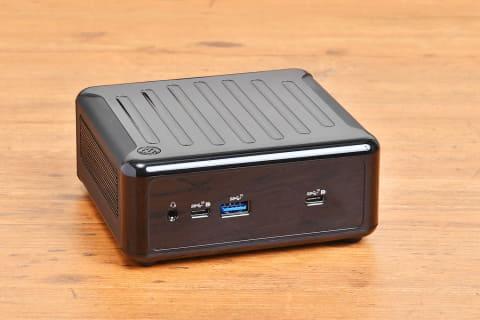PC4-25600 compatible memory and NVMe compatible SSD are recommended
Now, as for the memory to be installed, this time the Crucial brand PC4-25600 (DDR4-3200) compatible SO-DIMM "Crucial CT2K8G4SFS832A" chose. Since it is a native compatible model that does not require setting the memory clock, it is recognized as a PC4-25600 compatible memory without any special settings just by installing it.
Micron's Crucial CT2K8G4SFS832A. SO-DIMM memory for PC4-25600. It will be a 2-disc package with an 8GB moduleIn addition, the 4X4 BOX-4800U/JP used this time does not have detailed memory setting items in UEFI, so be careful when using so-called "overclocking memory". In the case of overclocked memory, for example, to use it with PC4-256000, it is necessary to make settings in UEFI, because if you do not make this setting, slower settings will be applied. Therefore, in order to use the memory as a PC4-25600 on this machine, a natively compatible module such as the Crucial CT2K8G4SFS832A is required.
When I checked with ASRock about the specifications, they said that it emphasizes stability and safety, and that overclocking memory is not supported. Considering that it is an ultra-compact PC that cannot use a powerful power supply unit or power circuit compared to a general-sized desktop PC, this correspondence is inevitable. Even with the same Crucial brand memory, the "Ballistix" series, which is popular with gamers, has overclocking specifications, so in a case like this, choose the standard Crucial series that is familiar with the green board.
Speaking of Micron, by building a flow in which everything from chip production to module processing is completed in-house, reliability is enhanced and boasts a strong track record in the enterprise market. Micron's Crucial brand products are also very popular among self-built PC users. Since memory failure affects the entire PC, the merit of combining such highly reliable memory is great.
The reason for choosing the PC4-25600 compatible memory is that the CPU's built-in graphics function is greatly affected by the memory clock. The graph below compares the performance of graphics processing by inserting "CT2K8G4SFS824A" of the same capacity compatible with PC4-19200.
Measurement result of PCMark 10 Measurement result of 3DMark Measurement result of Rainbow Six Siege (measured with built-in benchmark function)
There seems to be no big difference in the results of PCMark 10, which reflects the feeling of everyday operation. With the high processing power of the current PC, it is difficult to experience the impact of the memory clock, and the operability of Windows 10 does not change significantly between PC4-25600 compatible memory and PC4-19200 compatible memory. However, the built-in GPU, which uses the main memory for graphics processing, is easily affected by the speed of the memory, and it can be seen that there is a difference in the level that cannot be ignored in 3DMark and actual PC games.
If the price difference between PC4-25600 compatible memory and other memory is large, there is an option to choose the cheaper one. However, in reality, there is almost no difference, or the difference is only about 1,000 yen to 1,500 yen. Considering this situation together, you should still choose a model compatible with PC4-25600.
For the SSD, I also chose Micron's "Crucial P5 CT1000P5SSD8JP" (1TB model). It is an NVMe compatible SSD that is installed in the M.2 slot, and is a high-speed SSD that reaches 3.4 GB/s for sequential read and 3 GB/s for sequential write. The actual selling price is around 17,000 yen, which is relatively low and easy to purchase for a 1TB NVMe compatible SSD.
Micron's Crucial P5 CT1000P5SSD8JP. PCI Express 3.0 x4 NVMe compatible SSDThe result of actually embedding in 4X4 BOX-4800U/JP and running CrystalDiskMark is as follows. It demonstrates excellent read/write performance according to the specifications, and the startup and behavior of Windows 10 and the operation of various applications are also good.
CrystalDiskMark measurement resultsThe Crucial P5 does not have a heat sink, and the 4X4 BOX-4800U/JP is compact, so the interior is narrow and some users may be concerned about heat generation. First, the idle temperature in an environment where the temperature is 23.8°C is 44°C according to HWMonitor 1.44.
The maximum temperature when running the "Full System Drive Benchmark" (a test that measures the processing performance as a system drive) included in PCMark 10, which puts a heavy load on the SSD, is 57°C. Furthermore, when copying a 100GB file within the system drive (the load is slightly high because reading and writing are performed on the same drive), the maximum temperature was a little higher at 71°C, but the performance decreased during the work. It doesn't appear to be there.
If you choose from a slightly cheaper price range, we also recommend Micron's "Crucial P2 CT1000P2SSD8JP". Although the sequential read is 2.4 GB / s and the sequential write is 1.8 GB / s, which is inferior to the Crucial P5, it is overwhelmingly faster than the SATA 3.0 compatible model, and you can expect usability like an NVMe compatible SSD. The actual selling price is around 14,000 yen, which is reasonably priced.
Micron's "Crucial P2 CT1000P2SSD8JP". This is also a PCI Express 3.0 x4 NVMe SSD. CrystalDiskMark measurement results for P2 (1TB model), which is relatively cheap in the middle range classIf you want a large capacity anyway, there is also the option of a SATA 3.0 SSD. Although the price difference has decreased compared to before, large capacity models such as 1 to 2 TB are cheaper than NVMe compatible SSDs. SATA type M.2 SSD is also an ant, but 4X4 BOX-4800U/JP has a 2.5 inch shadow bay on the bottom, so the widely used 2.5 inch type can be used without problems.
In addition, since it has both an M.2 slot and a 2.5-inch shadow bay, the system drive is a 500GB Crucial P5, which is relatively inexpensive but high-speed, and 1 as a place to store data and large applications (games, etc.) A combination configuration such as a 2TB 2.5-inch SATA SSD is also possible. The 4X4 BOX's appeal lies in its flexible storage configuration.
The recommended SATA SSD is "Crucial MX500 CT1000MX500SSD1/JP". Sequential read is 560 MB / s, sequential write is 510 MB / s, top class performance among 2.5 inch SSD. The actual selling price is around 13,000 yen. If you want to keep the price down even a little, we recommend the “Crucial BX500 CT1000BX500SSD1JP”. This is also a 2.5 inch SSD, sequential read is 540 MB / s, sequential write is 500 MB / s. Actual selling price is around 12,000 yen

